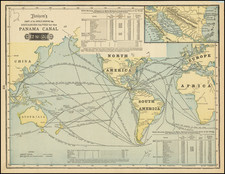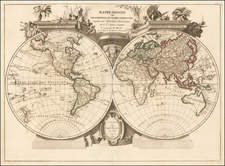The First Printed Map To Show California, Contemporaneous with the Sebastian Cabot World Map.
The Rediscovered "Florentine Goldsmith's Map."
A historically significant world map of the highest rarity, showing breakthrough geographical discoveries, which has historically been known as the "Florentine Goldsmith's map."
For much of the last 5 centuries, this map was lost to history until its rediscovery in 1864 by an Italian bookseller. The map was initially poorly understood, with Frederick Startridge Ellis in 1884 dating the map to circa 1535 and claiming, rather mysteriously, that the map was made by a "Florentine goldsmith." The next hundred years elucidated little further despite the discovery of the four known examples of the map (including the present example), with Shirley listing the map not once, but twice (61 and 98), with two different dates.
By the 21st century, scholarship had settled on a Venetian origin of the map, consistent with that city's engraving and cartographic styles. The further discovery of a dated derivative manuscript map definitively showed that this map must predate the year 1552, although no further refinement of the date was attempted. Here we re-examine the map and publicize two important discoveries: that the map almost certainly dates from the period 1542-1546, and that the map exists in two previously undescribed states.
Our refinement of the date to the period 1542-1546 makes this map contemporaneous with the Sebastian Cabot world map of 1544 (known in a single example at the Biblioteque National de France). Together with the Cabot map, the Florentine Goldsmith's map represents the first known depiction of California on a printed map, consistent with the tradition of Venetian maps being at the forefront of the depiction of the Cortez and other Spanish discoveries from this period.
The map is inextricably tied to the Venetian cartographic tradition of the 1540s, led by Battista Agnese and Giacomo Gastaldi. The map shows a peninsular configuration of California, as first depicted in 1542 on Battista Agnese's manuscript chart of the Pacific Ocean held by the Vatican. Further, this map shows the immense Sea of Verrazano, also depicted by Agnese during the first half of the 1540s, as shown on this 1542 manuscript world map. By 1546, this Sea of Verrazano configuration was out of style, when the first Gastaldi world map (here faithfully reproduced by Gerard De Jode in 1555) introduced the Quivira concept of an oversized North America connected to Asia. While the Sea of Verrazano did appear on later maps, for example on Gastaldi's own 1548 Carta Marina Nova Tabula, it was substantially smaller in size and only northward facing, without an immense arctic continent. This progression is further explicated here.
The unique geography shown on this map is replicated only on a single other known map, a 1552 manuscript world map by Cretan chart maker Giorgio Sideri's (more commonly known as Calapoda). The fact that the toponyms on the printed map are far more developed, that the manuscript contains spelling errors not present on the printed map, and that the manuscript bears little resemblance to Calapoda's other work has led researchers, including Suarez and others, to conclude definitively that Calapoda copied the printed map. For this reason, previous scholarship has established the dating of the map as pre-1552, although other commentators have stopped short of opining when, exactly, the map was published.
In addition to its unique cartography, the map's sophisticated circa 1542 Venetian decorative elements are exceptional. Already, in 1864, the engraving was referred to as first-rate, and, more recently, it has been attributed to a Venetian workshop by Bifolco and Ronca, and others. This timing, locale, and high level of engraving are cause enough to raise the question as to whehter the map was possibly by Gastaldi himself, one of the very few mapmakers at the time who looked beyond the shores of the Mediterranean. There are connections to be drawn between this map and some of Gastaldi's later, dated works, including his 1548 Universale Novo, although this attribution is speculative. If the map was, in fact, executed by Gastaldi, it would be his earliest-known world map.
Geography and Projection of the Map
In North America, the map shows a massive Sea of Verrazano bisecting the continent. The continent is connected to Asia through a narrow isthmus labeled "La Florida" which connects to the "Tierra del Bachalaos" and the "Tierra del Laborador." Further south, Mexico City is named "Temitistan." This is the only city shown on the map.
South America possesses several place names, but it lacks the depiction of the Amazon, a notable omission when compared with other maps of the 1540s and 1550s. Particularly following the Orellana expedition that returned to Europe in 1543 and the depiction of the river on the 1544 Cabot map (Shirley 81) and the 1546 Gastaldi map (Shirley 85), it becomes common to see the Amazon represented as a long, sinuous river on most maps. The Straits of Magellan are named, and a southern continent is shown extending to the pole.
The map represents a relatively early adoption of an oval world-map projection. While the projection was first used by the Florentine mapmaker Francesco Rosselli in 1508, it was not widely used until after Bordone, Munster, and Gastaldi all used it (all in the period 1528-1546). This projection represents the whole world without loss, which is important for American cartography as many previous projections would truncate the western portion of the Americas and the Pacific.
History of the Map's Rediscovery
The first modern record of the map is its mention as Lot 139 in the 1864 fifth sale catalog of the (somewhat infamous) collection of Guglielmo Libri, Catalogue of the Magnificent Collection of Precious Manuscripts and Objects of Art and Vertu. Libri was a prolific Italian book thief who was forced to flee to England from France, where he was accused of book theft, only to have most of the collection proved stolen and claimed by the French government in 1888. That issue aside, the catalog entry is certainly bombastic:
139 MAPPAMONDO, engraved in Copper, between 1530 and 1540, by a first-rate but unknown Italian engraver.
In this beautiful Mappamondo, Peru is marked, but not Chili. The North American Continent is extremely narrow at Florida, the coast of which is marked as being on the side of the Pacific Ocean, and the American Continent is connected with Asia by a long circuit. This Mappamondo is within an ornamented border with six medallions, containing six heads of such an admirable fineness, that they must have been drawn by one of the greatest artists of that time. We do not recollect having seen anything so fine in any engraving of the whole of the XVIth Century. Dimensions: about 12 English inches by 8½, or 31 centimetres by 22. The obverse of this Mappamondo is blank.
The map then appeared in an Ellis & White catalog in 1884 and again in Sotheby's Ellis sale of 1885, Lot 2044 (see Catalogue of The Valuable and Extensive Collection of Books Formed by Mr. Ellis Of 29, New Bond Street.), where it is described as follows:
2044 MAPS OF AMERICA. A Very early and remarkable Map of the Two Hemispheres, measuring 7 7/8 x 11 1/2 in. engraved on copper by an Italian engraver of the earlier half of the 16th century and probably the work of a Florentine goldsmith about 1535, though the map appears to have been prepared by a Spanish navigator, as must be surmised from the Spanish words found in it, e.g., "Stech," "Tierra," "El Peru", &c. The ornamental work and the beautiful heads in the border are clearly the work of an Italian artist.
Undescribed by Harrisse, and probably unique. The heads within circles at the right and left hand top corners are probably intended to represent Columbus and Vespucius.
This entry spurred Henry Harrisse to include an entry for the map in his 1892 Cartographia Americana Vetustissima section of The Discovery of North America, as entry 194. He truncates the description given in the aforementioned catalog, which has resulted in some ensuing confusion about the identity of the map. Harrisse speculates that the map is the same as one listed in a "lately deceased" French bookseller's catalog, however, the descriptions of the two maps do not correlate.
Harrisse's cataloging led Shirley to include it as entry 61 in The Mapping of the World. In a 2000 article in Imago Mundi, Gregory C. Mcintosh pointed out that Shirley 61 (which only cites Harrisse) and Shirley 98 (which cites at least two then-recently discovered examples) were, in fact, the same map.
We continue the historiography of this map by here identifying, for the first time, two states of the map.
States
This example of the map is a previously-undescribed second state. We note several differences between this example and the digitized Phillips Academy Andover example, as well as the example pictured in Bifolco & Ronca. We find no changes to the cartography, however substantial reengraving has been done to the decorative borders in order to strengthen the worn plate. For instance, in the lower-left portrait, the engraved lines shading the background have now been strengthened with cross-hatching. The first state only has vertical engraved lines in this background.
Rarity
Bifolco & Ronca note four known examples of this map, including the present. Institutional holdings are JCB and a badly damaged example at Phillips Academy Andover with the manuscript title "Universalis de terrao orarium ex vera recent."
Bifolco and Ronca Tav 16.
Suarez, Shedding the Veil, 28.
Wroth, L.C., Verrazzano, p. 194-195, 299, 318 plate 33.
McIntosh, The Rediscovery of Two Lost Sixteenth-Century World Maps, Imago Mundi 2000.









![[Early Photographic Facsimile of the 1529 Ribero World Map]](https://storage.googleapis.com/raremaps/img/small/67279.jpg)


![Mappe-Monde ou Carte Generale du Globe Terrestre, Representee en deux Plan-Hemispheres [World Map or General Map of the Earth, Represented in Two Plan-Hemispheres]](https://storage.googleapis.com/raremaps/img/small/93262.jpg)
![[Hand Drawn Map of the World]](https://storage.googleapis.com/raremaps/img/small/86629.jpg)
